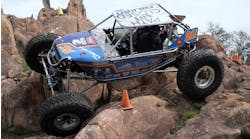Here at Daytona, the factory linked teams from BMW, Chevrolet Corvette, Ford, Ferrari, and Porsche have all chosen Michelin as their respective technical partner in the only IMSA class (GT Le Mans) permitting open tire competition.
Looking at the first of the season’s two premiere 24 hour races, Chris Baker, Michelin motorsport director, North America, simply says, “Daytona is a different animal than Le Mans and we all respect the differences.”
The Circuit:
The 3.56 mile Daytona International Speedway circuit incorporates an infield road section into a layout that includes significant portions of the famed 2.5 mile high-banked oval superspeedway. With eight left turns and just three right handers, the right side tires do the work for much of the lap, with 31 degree banking on the oval turns and 18 degrees on the tri-oval section where the cars attain their absolute maximum top speeds--adding to that load.
“This will be our third Rolex 24 At Daytona since the merger took effect in 2014 and we are building our technology base each year as we gain data and insights,” said Baker. “We know that the right side tires take the abuse here and we have a robust solution for our technical partner teams.”
“The banking and constant traffic create some different challenges than those we see at Le Mans,” said Baker. “Here at Daytona in January we expect less than 11 hours of daylight for the race compared to the 16 hours of daylight at Le Mans in June.”
Both races start at approximately 3:00 p.m. local time, but only the first three hours at Daytona are run before sunset while over seven hours are in the books before darkness arrives at Le Mans. Although the circuit is lighted, night running means cooler temperatures, (sometimes in the low 40 degree F range) and greater risks of traffic and heavy braking to avoid contact.
The fields are nearly the same size (approx. 55 cars). The Daytona track length is 3.56 miles compared to 8.47 miles at Le Mans, making lap times here at Daytona much quicker and with more traffic as each entry has less than half the track real estate to navigate and laps take only half the time.
Pit Rules and Tire Use:
The NASCAR style IMSA pit rules at Daytona are also different than those in effect at Le Mans. Here, teams can change tires and work on the car during refueling while Le Mans separates tire changes and car repairs from fueling with a very limited number of mechanics allowed to change tires during pit stops.
That approach negates the benefits of Michelin’s renowned ability to multi-stint tires. (The 2015 Le Mans winning Porsche 919 Hybrid used 10 sets of Michelin tires to cover 3,425 miles while the Daytona winning Chip Ganassi Racing Ford EcoBoost DP used 30 sets of a spec class tire to complete 2,634 miles.) The result is that IMSA teams change tires more frequently as there is no pit time saved by multi-stinting tires. “The only advantage to double-stinting tires here at Daytona is to keep hot tires on the car when the track gets cold during the night or during a long caution period,” said Baker. Tire warmers are not allowed in IMSA competition.
The MICHELIN tire options:
Michelin teams will have two temperature range versions of the company’s second generation tires designed for IMSA specific tracks. “Both tire options use a medium compound that has worked well in testing,” said Baker. “We have MICHELIN medium/cool temperature tires designed for cooler temperatures such as during the night and medium/medium temperature tires for warmer track conditions.”
If rain becomes a factor, Michelin teams are confident that the Michelin WEC wet tires introduced at the 2015 season-ending Petit Le Mans will perform well. Porsche’s Nick Tandy and Patrick Pilet earned the overall race victory in their GTLM entry, besting all of the faster, more powerful rival fitted Prototypes.
Michelin also has an option for damp or drying track conditions. Based upon tire technology developed in the FIA World Rally Championship and extended more recently to Michelin’s revolutionary Premier A/S street tire, Michelin teams have a slick tire with a compound designed to quickly arrive at the proper operating temperature range.
“A 24 hour race always writes its own story,” said Baker. “With the debut of the Ford GTs, new cars from BMW and Ferrari, and the updated Corvettes and Porsches, we expect a very tight battle. Our goal is to provide each of our technical partner teams with the tires and technical support to help them perform at the highest possible level for the full 24 hours.”



